Walking down Shanghai Street, you note the old red brick building that was once the engineer’s office of the Yau Ma Tei Pump Station. The building marks your transition into the neighbourhood that it once served. All around it, newer buildings rise up out of the concrete. Shops selling cooking equipment line both sides of the street and occasionally they are broken up by temple materials shops. Both types of businesses give you a feeling for the district. Crossing to the parallel road, you begin to walk down the quieter stretch of Temple Street. The street focuses its energy on food. In the light of day, not much is happening. A few small restaurants offer noodles and dim sum of high quality and low price. At night, the whole length of the street is filled with stalls, smells and the colours of Temple Street Night Market. Coming to the end of the short section, the road is intersected by the place that gives it its name.

The Tin Hau Temple Complex is one of the largest in Hong Kong. Tin Hau (天后 Tiān Hòu), also known as Māzǔ (媽祖), is the Divine Empress and Goddess of the Sea. In Hong Kong, the sea has always been a provider and sustainer. The people and the sea are interwoven, but it can be a destroyer as well as a preserver of life. The native inhabitants worshipped sea deities in order to appease them and stay safe and prosperous. Today, the practice of worshipping these gods remains primarily the most influential religion in the territory. The temple complex at Yau Ma Tei is not within sight of the coastline, but the landlocked sea goddess temple once sat on the harbour-front of a shallow bay, until the land was reclaimed over several years. Originally built in 1876, it was once used by the fishermen who left for the open seas from the small harbour.
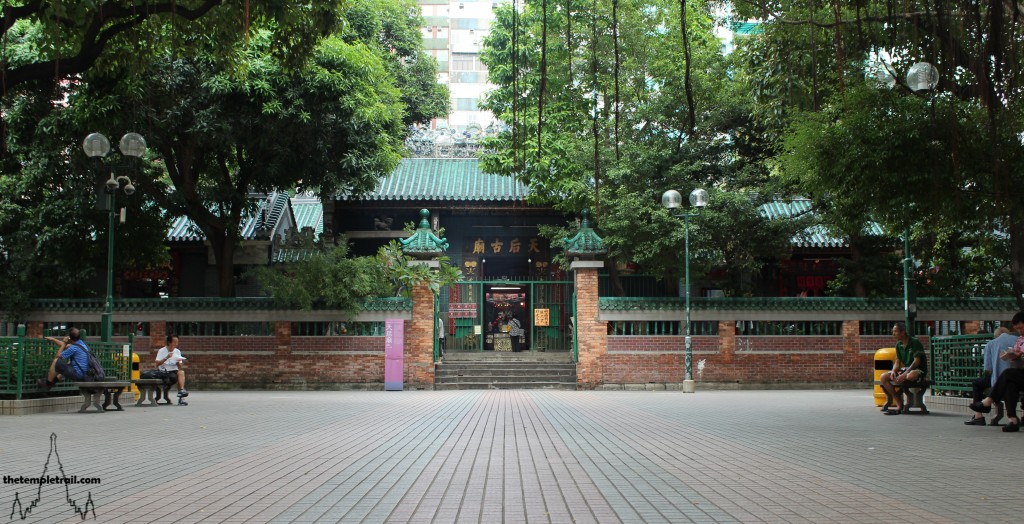
Approaching the front of the complex, you enter the shady Yung Shue Tau. The public square that is sheltered by the gnarled and ancient banyan trees that it takes its name from is full of local people enjoying respite from the sun. Old men play jeuhng kéi (象棋 xiàngqí) Chinese Chess, as others laze about and take a few moments rest. Striding up the tree-lined avenue, you climb a set of stairs and enter the complex. Rather than heading straight into the main sanctuary, you pivot and go left. The temples are all part of one building that has been subdivided into five long, narrow sections. The one furthest to the left is the Old Kwun Yum Temple. Revered in both Taoism and Buddhism, Kwun Yum (觀音 Guānyīn) is a universally appealing bodhisattva to the Buddhists and immortal to the Taoists.
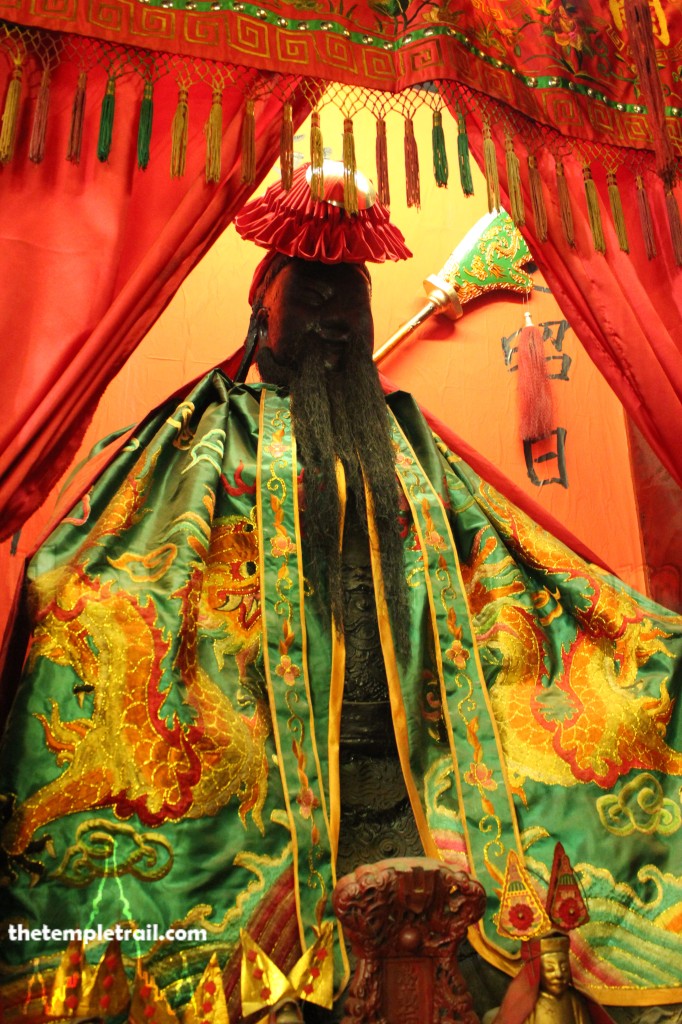
The Old Kwun Yum Temple was originally called Fuk Tak Temple and was added to the complex in 1894. The temple was erected to honour Fuk Tak Kung (福德公 Fúdé Gōng), a deity associated with The Earth God To Dei Kung (土地公 Tǔ Dì Gōng), but was later rededicated to Kwun Yum. Cutting through clouds of incense, you approach the offerings table and main altar. The black statue of Kwun Yum occupies the space and beneath her, you see the idols of Pau Kung (包公 Bāo Gōng) – the God of Justice, Fuk Sing (福星 Fúxīng) – the God of Happiness, and To Dei Kung. The ominous statue sits directly next to another large black figure. This bearded statue is Kwan Kung (關公 Guān Gōng), the deified Three Kingdoms Period general Guān Yǔ (關羽). His presence is, despite the name of the temple, the most imposing, and he seems to dominate the space. Beneath him, you notice small statues of To Dei Kung and his spouse To Dei Po (Tǔ Dì Pó). Also, an altar to the God of Wealth, Choi Sun (財神 Cái Shén), lies at the foot of Kwan Kung. Returning to the door of the temple, you pass the miniature effigies of the Tai Sui (太歲 Tàisuì) Year Gods and the statue of Kam Fa Leung Leung (金花娘娘 Jīn Huā Niáng Niáng), the Patron of Pregnant Women.
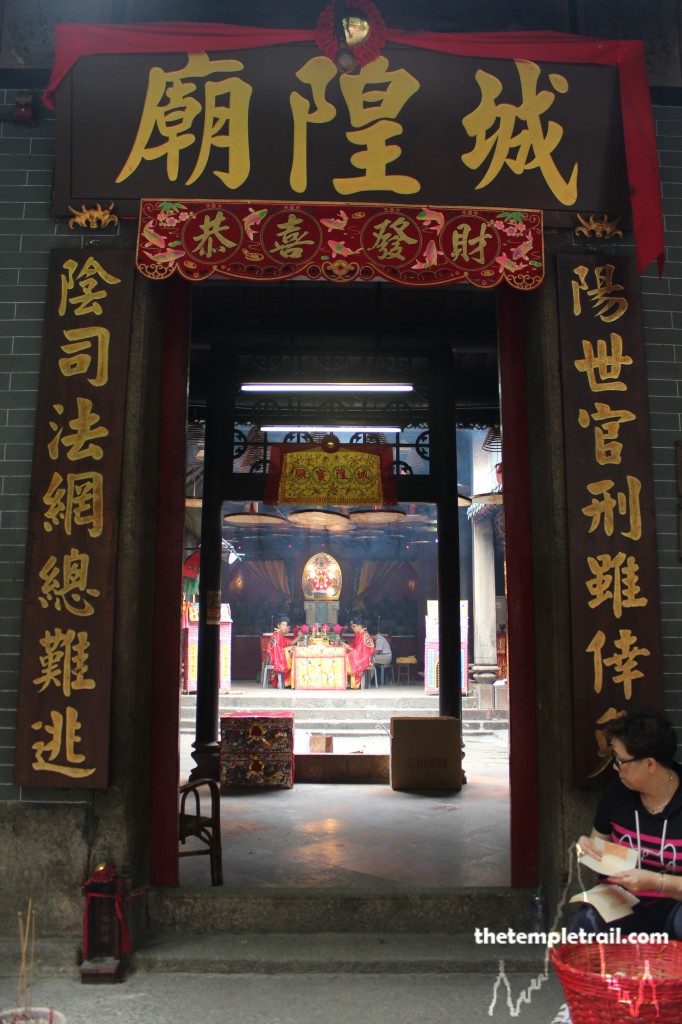
In the sunlight and smoke-free air, you take a short breather before darting into the next temple. The temple of the City God Shing Wong (城隍 Chénghuáng) is a very important shrine for the local people. Entering the decorative doorway, you immediately notice the colourful paper models of earthly possessions. These offerings are for the deceased relatives of Hong Kongers, as Shing Wong is responsible for the care of the dead. His job is to ensure that everyone gets what is coming to them and as you pass through an open courtyard, ancestor tablets from local families line the walls. Ahead of you, some priests are chanting as part of a ritual and the sounds reverberate off the walls as they exit through the open roof. Approaching the main altar, you see the moustachioed image of Shing Wong surrounded by his minions. He is flanked on both sides by the ten Judges of the Underworld and the Soldiers of the Underworld. The judges are charged with weighing the sins of the souls of the dead and the soldiers with meting out the punishments. The temple is very smokey. The paper offerings are burned to send to the dead in the underworld, so that they can have some items to make their existence there easier.
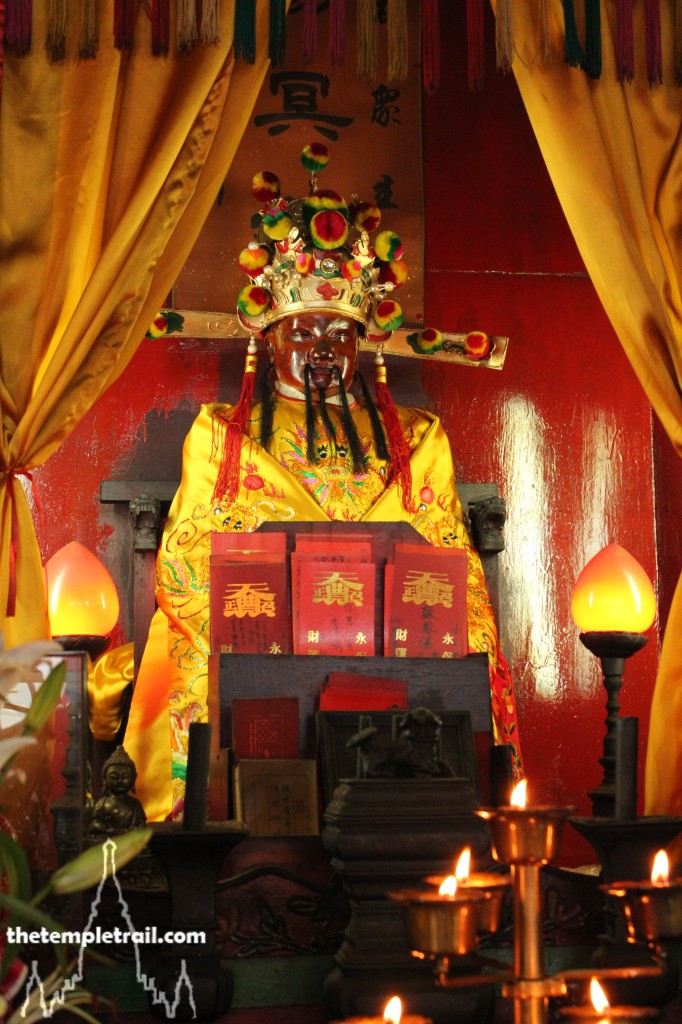
The next temple on your route is the central Tin Hau Temple. Tin Hau is worshipped all over the south of China and was a historical figure, as is often the case with Chinese gods. Born Lín Mòniáng (林默孃), she lived in the 10th century and came from the southern Chinese province of Fujian. She was from a fishing family and would stand on the shore wearing a red dress during storms and typhoons to guide sailors home. Legend has it that she fell into a trance during a typhoon and saw her father and brother drowning. She helped them both, but her mother woke her and caused her to drop her brother into the sea. Her father returned to land and told the miracle to the people. The legend goes on to state that she climbed a mountain and ascended to heaven as a goddess aged 28.
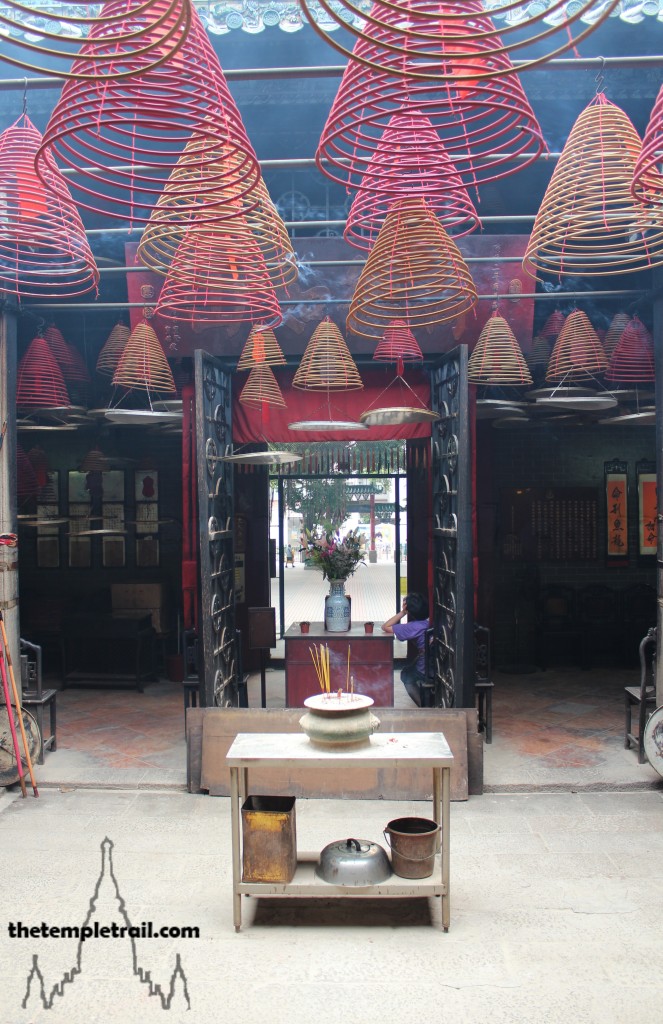
The grand doorway to the temple is flanked by lions and opens into the largest space of the complex. The dong chung(擋中 dǎng zhōng) spirit screen doors are open and you can see through the courtyard to the main altar at the back. Two Mun Gun (門官 Mén Guān) door officials keep tabs on you from either side. Crossing the smokey courtyard, you come to an altar that has an image of Lo Ji (老子 Lǎozǐ), founder of Taoism on it. The worship here is Taoist as well as Shenist. Behind the altar stand four large figures preceding Tin Hau. Two human and two demonic attendants guard the main image. The two humans are the Book Keeper and the Keeper of the Gold Seal of Tin Hau. These two officials record the virtues and failings of the people. Before them you stand toe-to-toe with Chin Lei Ngan (千裡眼 Qiānlǐ Yǎn) – Thousand Li Eyes, and Shun Fung Yi (順風耳 Shùnfēng Ěr) – Favourable Wind Ears. The two demons fell in love with Tin Hau, but she subdued them and they became her faithful servants and guardians. Carrying an axe, Thousand Li Eyes (a li is a distance of 500 metres) can see far and Favourable Wind Ears, who carries a club, can hear things that are far away.
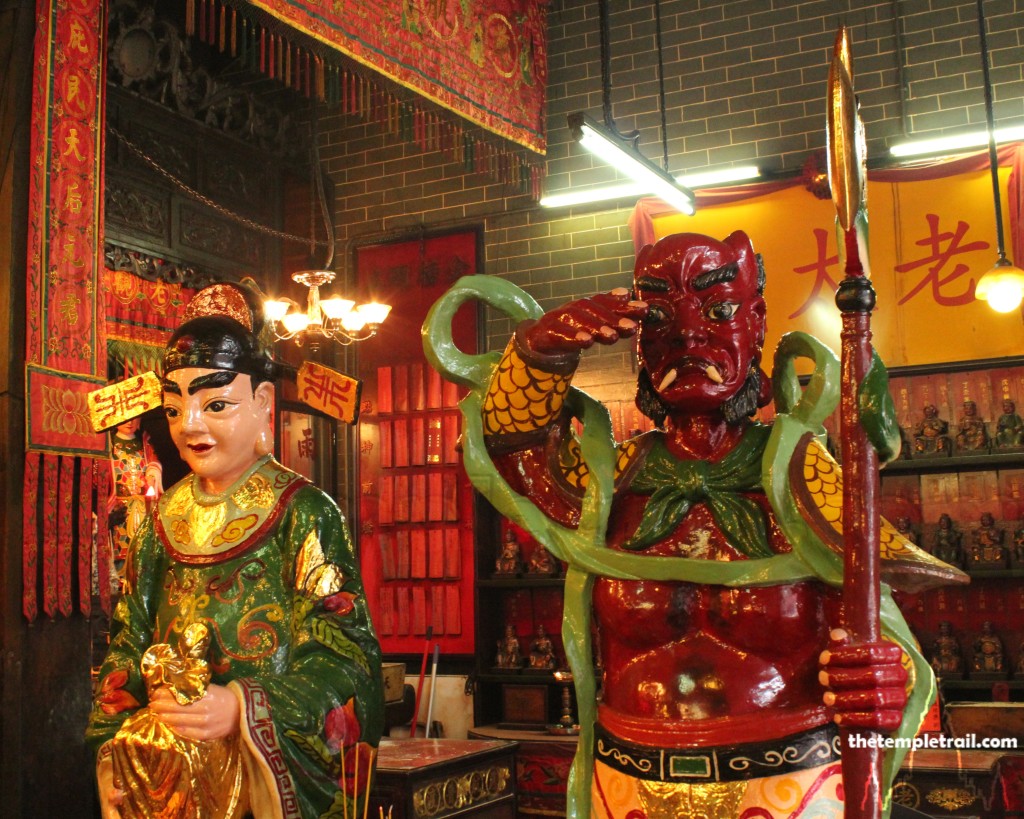
The empress herself watches you from her raised position. Her pale face looks down on you with smiling eyes. She is crowned with the royal headgear and a gentle radiance bursts forth from the statue. The kind image seems to project protective and motherly emotions. On either side of her, Pau Kung, Choi Sun and Kwun Yum sit in her presence. They are joined by Dei Ju (地主 Dì Zhǔ), the landlord deity, a manifestation of To Dei Kung. The array of gods is magnificent, but Tin Hau steals the show. Her beautiful visage glows among the darker figures. Turning around, you return to the front door and go to the final temple of the complex.
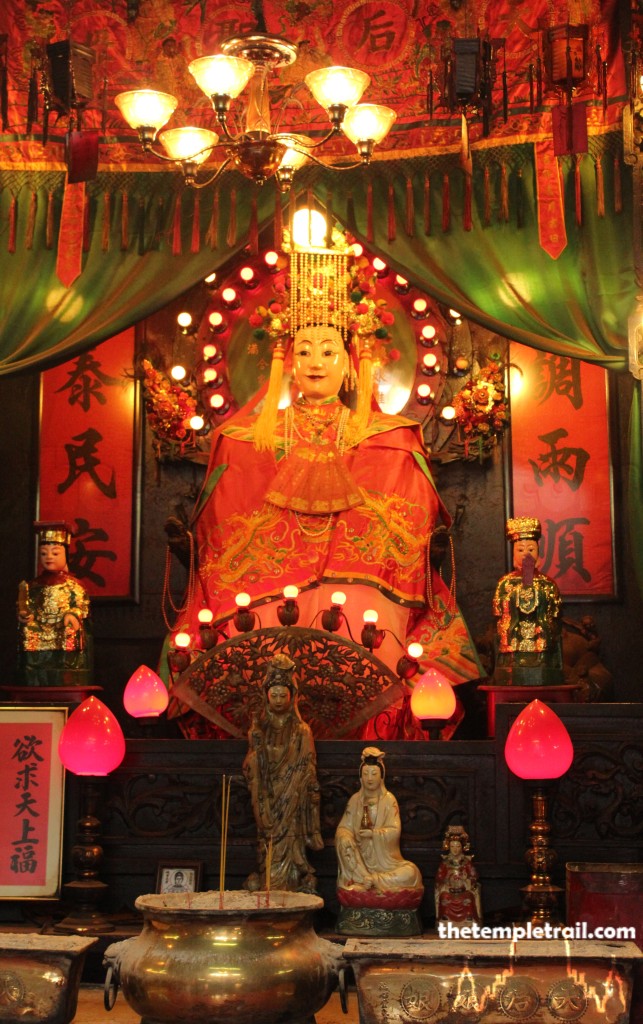
The new Kwun Yum Temple is dark, but passing the spirit doors, the bright courtyard reveals an altar called She Tan (社壇 Shè Tán) dedicated to the ancient district god, She Kung (社公 Shè Gōng). The district god is represented by an inscribed standing stone that rests in the centre of the small courtyard, but the temple was once dedicated solely to him. He is the god of the harvest and the protector of the area. Passing him, you delve once more into the dark and move towards the altar of the temple. Crossing the path of Choi Sun and To Dei Kung, you walk past rows of ancestor tablets. The main altar at the end is elaborate and striking. The left-hand side is occupied by Lung Mo (龍母 Lóng Mǔ), the Dragon Mother. As a human, she raised five baby dragons and was deified as a goddess of motherly love. Next to her is Gum Fa, the pregnant mother protector. On the far right of the altar are Kwan Kung and Pak Tai (北帝 Běidì), the Emperor of the North.
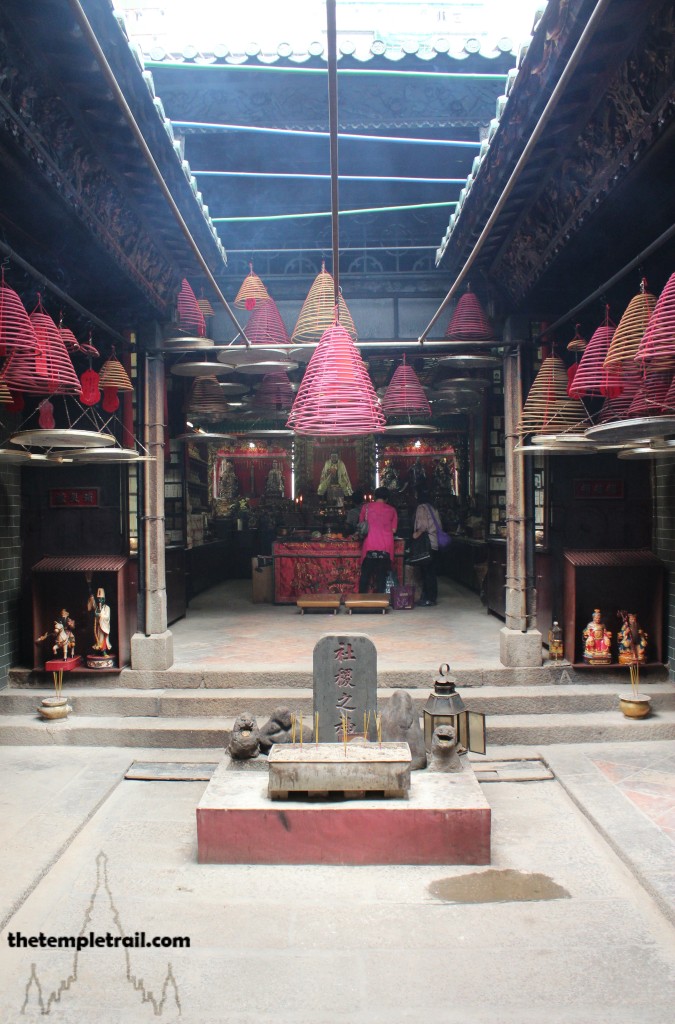
The centre of the altar is the resting place of Kwun Yum. To her right and left are Yuk Nui (玉女 Yùnǚ), the Jade Girl, and Kam Tung (金童 Jīntóng), the Golden Boy. Her two youthful attendants stand next to her while three Buddhas sit in front of her. There is a whole array of statuary surrounding her, including Wai Tor (韋馱Wéituó), a dharma protector, and Sūn Wùkōng (孫悟空) as the Monkey God Chai Tin Dai Shing (齊天大聖 Qítiān Dàshèng). The statue of Kwun Yum is serenely realistic and the compassion that people seek here is transmitted through her gentle gaze. Dressed in white, she is a beautifully crafted piece of Chinese carving. Returning from the darkness, you come back out to the main façade of the temple complex. To the far right is the locked and disused Hsu Yuen (書院 Shū Yuàn), an old Study Hall that sometimes houses fortune tellers. Looking the full length of the front, you fully take in the hive of temples. They are an integral part of the Hong Kong religious landscape and the well-kept state they are in is testimony to their functional significance.
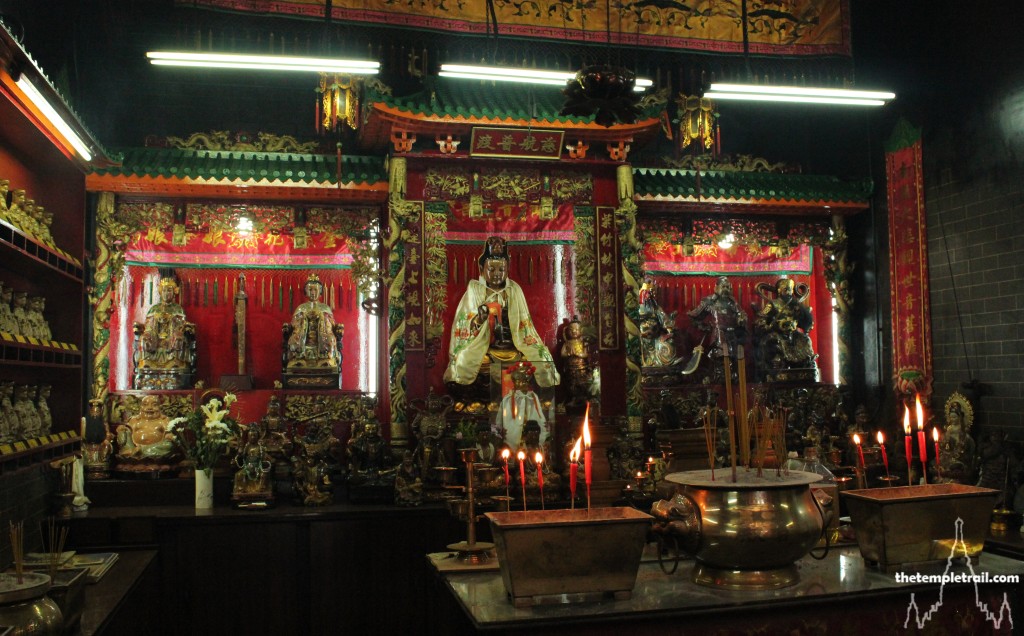
Walking back through the park, you see the community making the most of the space. This temple and its inhabitants look out for the interests of the locals. They gather in its proximity in order to glean some of the protective magic. As you leave the park, toothless old folk smile gummy smiles towards you as you head back to the non-stop craziness of Kowloon.
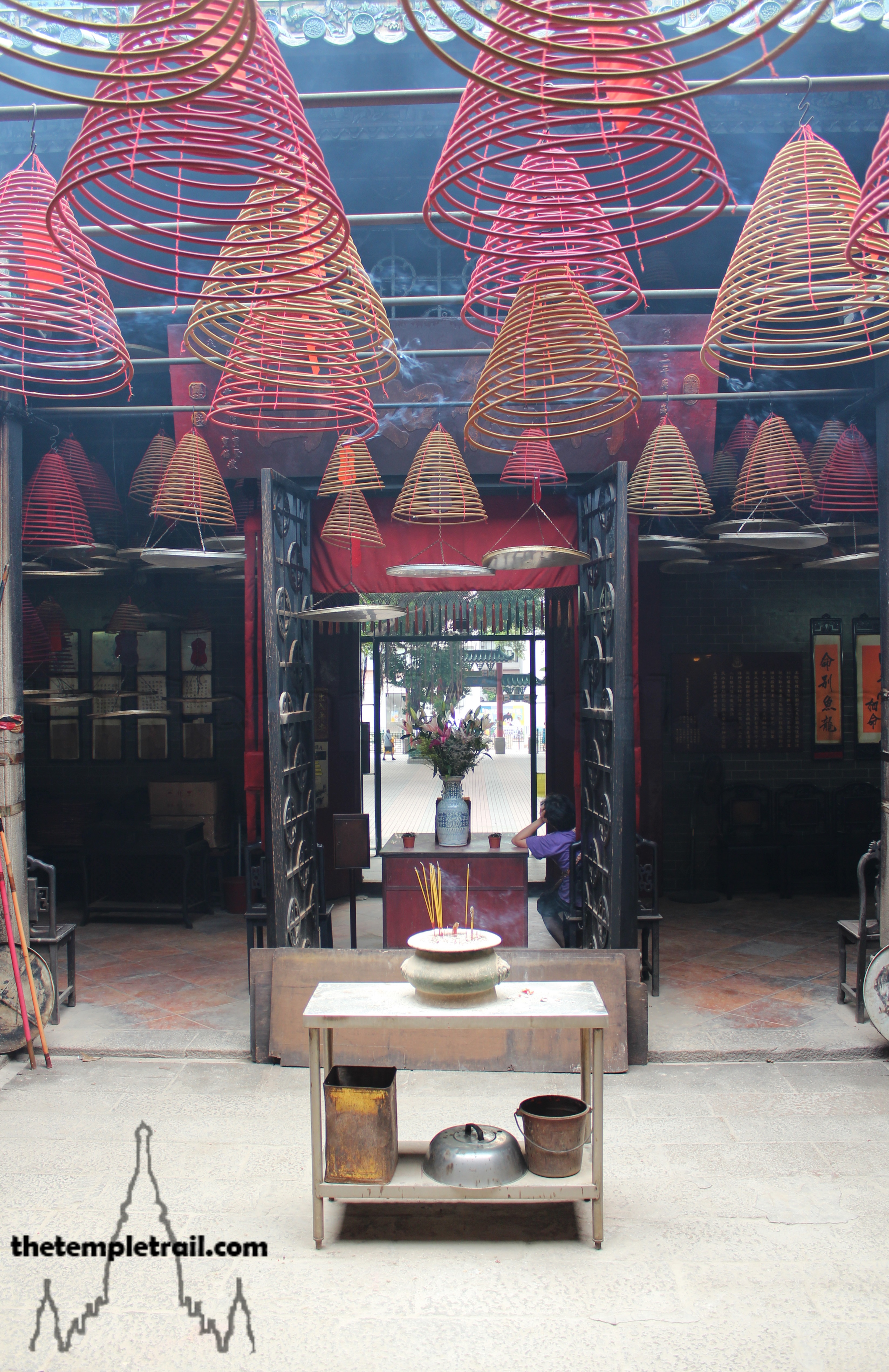
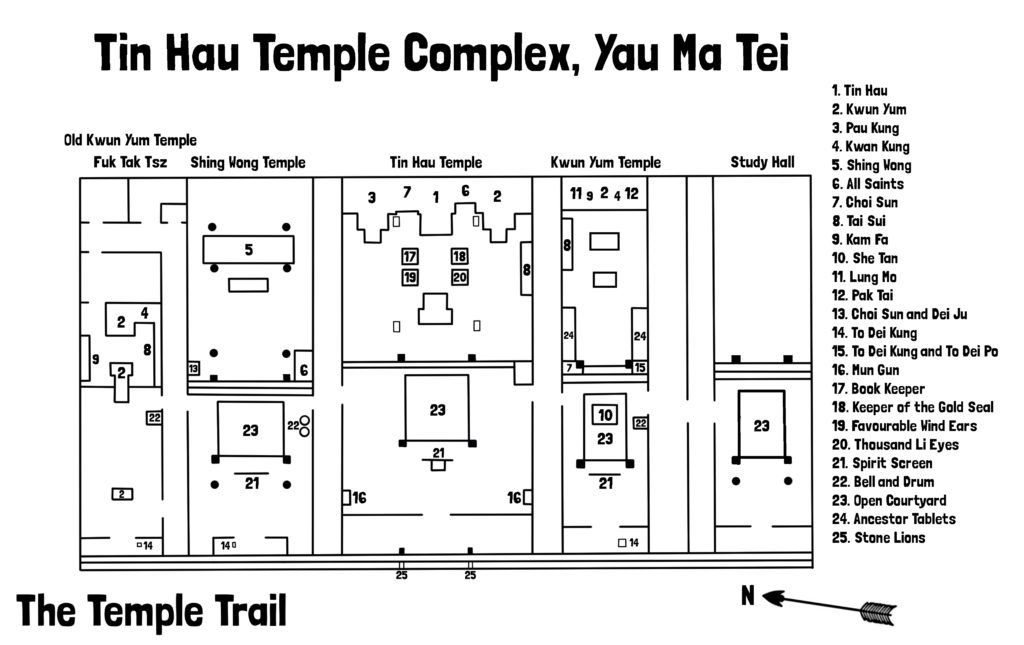
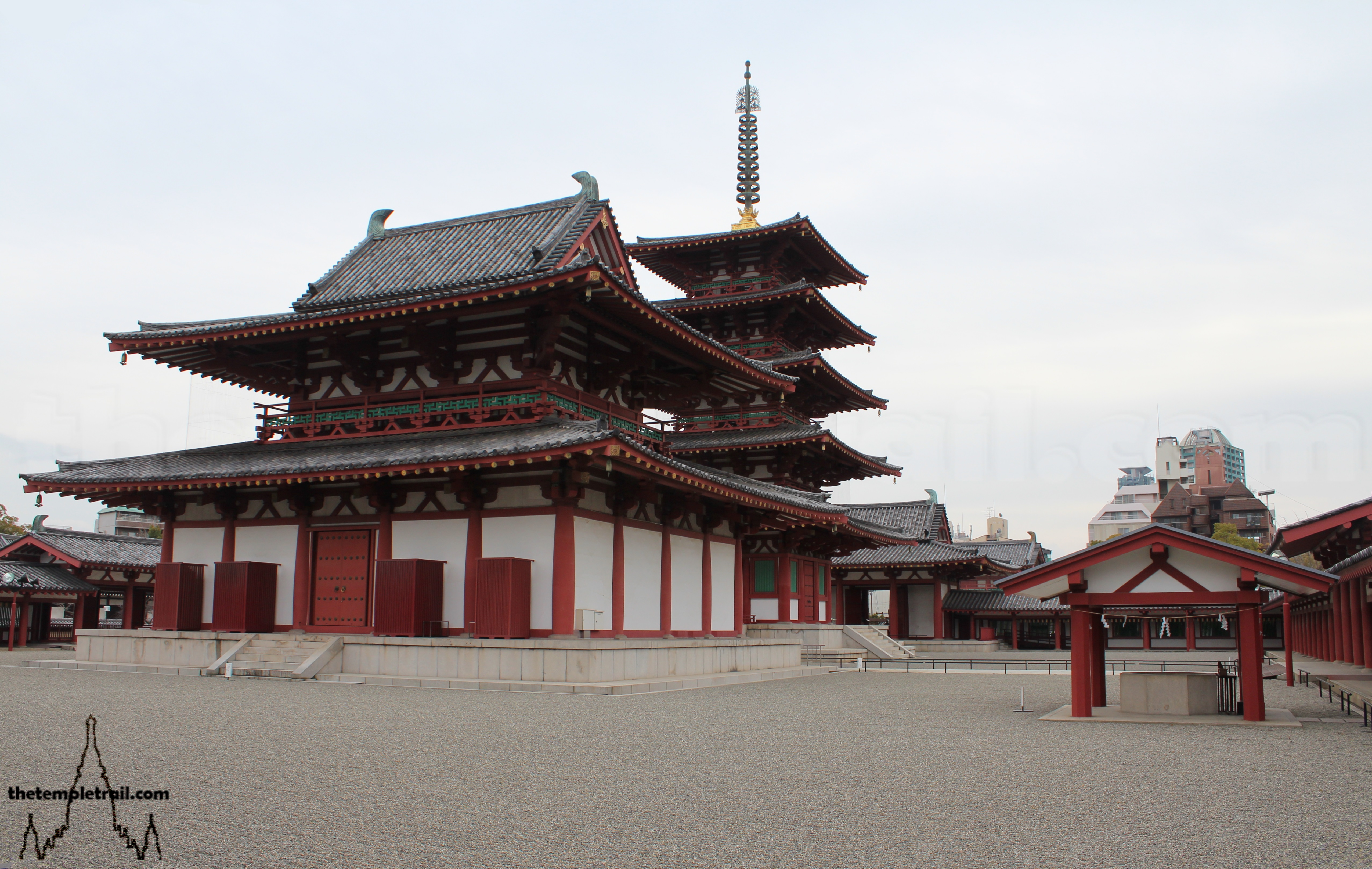 Shitenno-ji
Shitenno-ji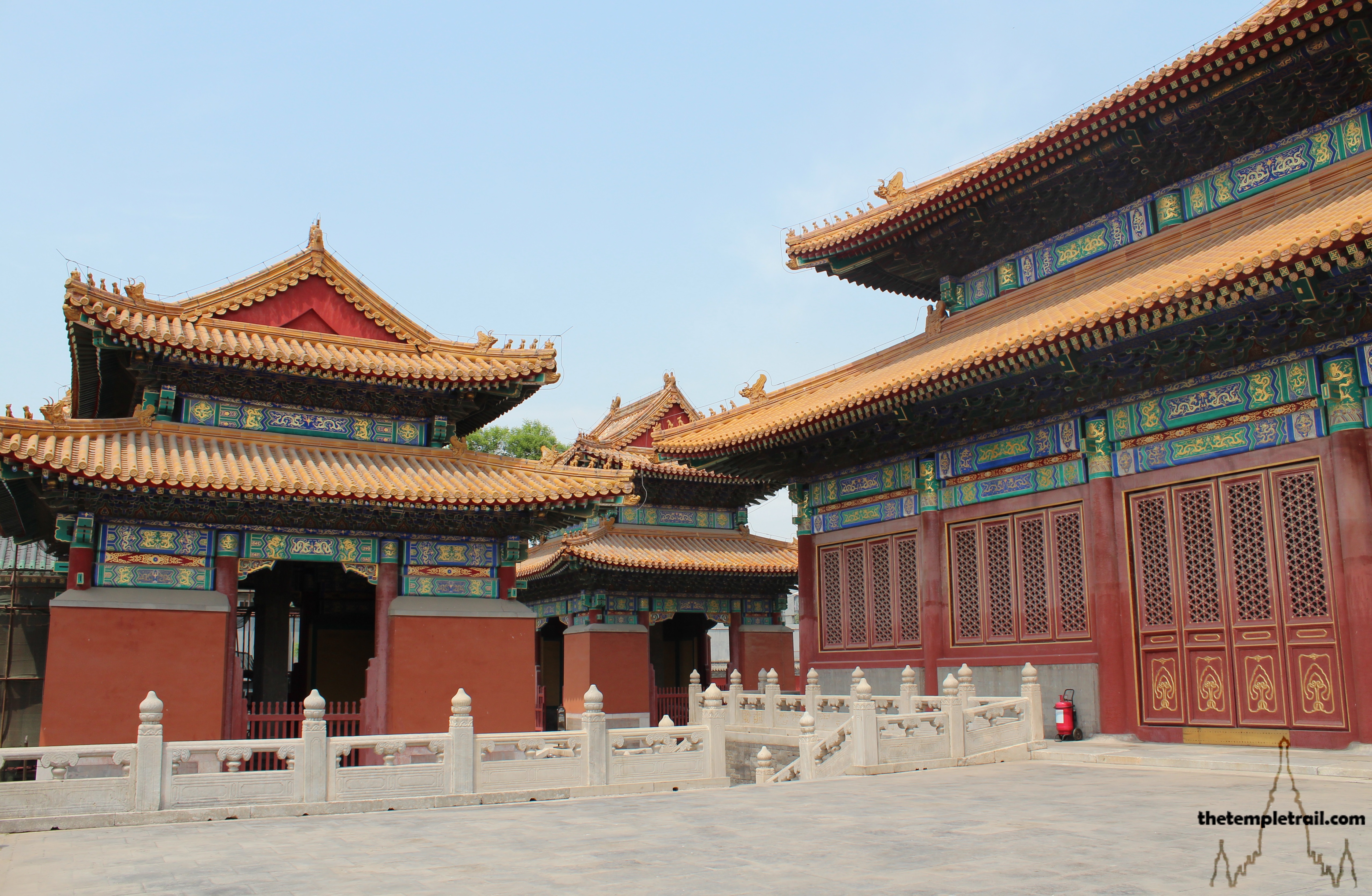
[…] Street Night Market: This popular street market is named after the Tin Hau Temple. As the sun goes down, the market is opened and it is absolutely amazing. The market serves […]